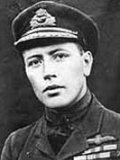Raymond
Collishaw


Name: Raymond
"Collie" Collishaw
Country: Canada
Rank: Lieutenant Colonel
Service: Royal Naval Air Service
Royal Air Force Units: 3W, 10N, 13N (RNAS)
47, 203 (RAF)
Victories: 61
Date Of Birth: November 22, 1893
Place of Birth: Nanaimo, British Columbia
Date Of Death: September 28, 1976
Place of Death: West Vancouver, British Columbia
In 1908 Raymond Collishaw joined the Canadian Fisheries
Protection Services at the age of fifteen. In January of 1916, he
joined the Royal Naval Air Service as a probationary Flight
Sub-Lieutenant. Eventually commanding the famous "Black Flight,"
he was the first pilot to claim 6 victories in one day and the
highest scoring ace to fly the Sopwith Triplane. When the war
ended, he remained in the Royal Air Force, with the final rank of
Air Vice-Marshal.
Quotes
"While in the air you constantly turned your head, first to one
side and then to the other, making sure that nothing was on your
tail. This, by the way, was the reason for the traditional silk
scarves worn by the fighter pilots." Raymond Collishaw
Distinguished Service Cross (DSC)
"In recognition of his services on various occasions, especially
the following: On 1 June 1917, this officer shot down an Albatros
scout in flames. On 3 June 1917, he shot down an Albatros scout in
flames. On 5 June 1917, he shot down a two-seater Albatros in
flames. On 6 June 1917, he shot down two Albatros scouts in flames
and killed the pilot in a third machine. He has displayed great
gallantry and skill in all his combats." DSC citation, London
Gazette, 24 July 1917
Distinguished Service Order (DSO)
"For conspicuous bravery and skill in consistently leading attacks
against hostile aircraft. Since June 10, 1917, Flight Lieutenant
Collishaw has himself brought down four machines completely out of
control and driven down two others with their planes shot away.
Whilst on an offensive patrol on the morning of June 15, 1917, he
forced down a hostile scout in a nose dive. Later, on the same
day, he drove down one hostile two-seater machine completely out
of control. On June 24, 1917, he engaged four enemy scouts,
driving one down in a spin and another with two of its planes shot
away; the latter machine was seen to crash." DSO citation, London
Gazette, August 11, 1917
Distinguished Service Order (DSO) Bar
"A brilliant squadron leader of exceptional daring who has
destroyed 51 enemy machines. Early one morning, he, with another
pilot, attacked an enemy aerodrome. Seeing three machines brought
out of a burning hangar, he dived five times, firing bursts at
these from a very low altitude, and dropping bombs on the living
quarters. He then saw an enemy aeroplane descending over the
aerodrome; he attacked it and drove it down in flames. Later, when
returning from a reconnaissance of the damaged hangars, he was
attacked by three Albatros scouts who pursued him to our lines,
when he turned and attacked one, which fell out of control and
crashed." DSO Bar citation, London Gazette, September 21, 1918
Distinguished Flying Cross (DFC)
"This officer is an exceptionally capable and efficient squadron
commander, under whose leadership the squadron has maintained a
high place in the Army Wing. He has carried out numerous solo
patrols and led many offensive patrols, on all occasions engaging
the enemy with great bravery and fearlessness. Up to date he has
accounted for forty seven enemy machines, twenty two in the last
twelve months." DFC citation, London Gazette, August 3, 1918
